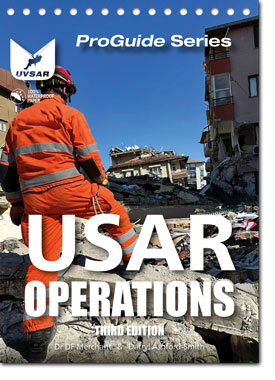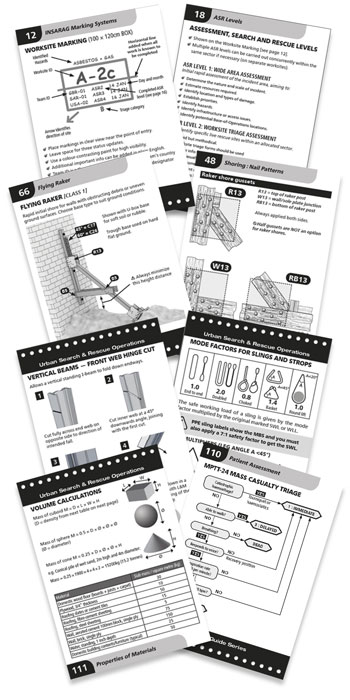Books: ProGuides: USAR Operations
FAQ ContentsISBN 978-0-9560784-7-6 (0956078478)
RRP £ 21.95

Used by thousands of rescuers across the world since 2008, ProGuides set the standard for high-quality, clearly-presented information in a compact and rugged format. Each A6-size coil-bound ProGuide is printed on 100% waterproof polymer paper, which can be washed or disinfected without damage, is resistant to tearing, and will not stick together even after months in a damp pocket.
Updated! The Third Edition was published November 2023 and has been fully reviewed and updated with the latest best practices, aligning the content with the current INSARAG and USACE-FEMA protocols.
Changes
- Structure marking/mapping and assessment (ASR) protocols match the INSARAG 2020 Guidelines (in force as of 2023).
- Timber shoring diagrams follow the latest-practice designs, e.g. preferring half-size gusset plates.
- Shore "design loads" agree with USACE-FEMA values where applicable [see below for explanation].
- Sloped-floor shores have been renamed (designs have not changed).
- The "u-box" raker base is retained as it remains an essential option for some surfaces (it was removed from USACE-FEMA publications).
- More detailed table of contents now lists every shore.
- Many improvements to the fine detail in diagrams.
- Updated checklists with greater emphasis on modern technologies, e.g. UAVs.
- Updated hot cutting guidance for window breaches.
- New casualty care triage information [GCS and MPTT-24].
- Crane hand signals have been removed as they are extremely country-specific.
- Blank forms have been removed to maintain the same cover price.
Important: Timber shore design loads
ProGuide USAR Operations was originally written for UK Fire and Rescue teams and as such it quoted the load capacity of timber shoring using the scheme developed in 2005 for the UK Government by Coventry and Aberdeen Universities. This tested cribbing, single T-Spot and Laced-Post Column shores built using UK-sourced grade C16 timber (EN 338, grain-parallel compressive strength 17 N/mm2, 2465 lb/in2) with 4x4-inch section posts and beams. Nail and bracing patterns matched the USACE-FEMA diagrams of the time (using full gusset plates throughout). They proposed a general rule that any single vertical 4x4-inch post can be rated at 25kN [2500kg] safe working load in linear compression. UK-trained teams have been taught to extrapolate that value for all other timber shore designs, so for example a Laced Post Column would be rated at 10000kg, and so would a 4-Post Vertical shore.
USAR teams elsewhere have almost entirely standardized on values published by the US Army Corps of Engineers in collaboration with FEMA in their Field Operations Guide [USACE-FEMA], currently on version 9. These quote values for both 4x4-inch and 6x6-inch timber (while 6x6 shoring is rare it can be required when dealing with large buildings and heavy concrete slabs). The USACE-FEMA scheme is based on "No 1 Douglas Fir" timber (grain-parallel compressive strength 1400 to 1800 lb/in2) and there is no simple add up the number of posts rule with each shore having specific capacities based on dimensions and angle. INSARAG does not publish policy on shoring design.
USAR teams across the world construct shores with almost identical layouts and nail patterns, but in some cases the load capacities in the US and UK schemes disagree by a large amount; and in opposite directions. USACE-FEMA rates a single T-Spot shore as used in the UK tests at 4000lb [only 1800kg] and a Laced Post Column at 32000lb [over 14500kg].
ProGuides are used internationally, so with the Third Edition we have adopted the following policy:
- USACE-FEMA Design Loads are listed where applicable for shores built with both 4x4-inch and 6x6-inch timber.
- The UK rule is explained in detail and values are quoted for the specific shore types in the Coventry tests.
- Construction patterns are the same; it is only the capacity (design load or SWL) that differs.
- Readers should work to whichever scheme they have been trained upon.
If you wish to order in bulk for a team or training centre please contact us. We accept purchase orders from UK government, military and public-sector agencies on 30-day credit terms; other customers are subject to status and may be asked to pay in advance.
Bookstores and retailers should click here for more information.
This product is exempt from EU GPSR under Article 51.
Contents
USAR Operations contains 113 pages - not forgetting our unique transparent protractor and ruler on the back cover - with everything a rescuer needs to know from initial searching and safety briefings to step-by-step timber shoring and hot cutting techniques. We cover pulley systems and loads for lifting and moving, confined space access and all the essential tips and tricks, resource lists and data tables you need. Down to the last nail, every diagram is crystal-clear to understand, even in the dark and the pouring rain.

- Principles of rescue scene management and team safety.
- Technical search strategies, resources and logistics.
- Mapping schemes and search safety checklists.
- Structural assessment - triage flowchart, material density tables and marking systems.
- Lifting and moving - crane operations, pulley systems, knots and lifting plans.
- Timber and Paratech™ shoring - calculations, safety and operational procedures.
- Timber shoring - nail patterns and detailed construction information for all standard forms.
- Breaching and breaking - resources, procedures, safety and supervision checklists.
- Hot cutting - resources, safety and management, cutting sequences.
- Confined space entry and systems of work.
- Casualty assessment, triage and life support protocols.
- Properties of common building materials and weight calculation equations.
- Metric-Imperial unit conversions.
- Transparent scale and protractor on rear cover.
Timber Shore patterns:
- 60°/45° Solid-sole rakers
- Flying rakers
- Split-sole rakers
- Multi-insertion-point rakers
- 'T' spots
- N-Post vertical and horizontal
- Laced-post columns
- Sloped floor perpendicular (type 2A/2B)
- Sloped floor friction (type 3)
- Window/door framing prefabricated
- Window/door framing built-in-place
FAQs
- If I order books for my team can you deliver to ...?
- We can ship to most countries around the world but there will often be duty and import tax to pay, so when you contact us we will quote based on the delivery address and value. Note that shipments to some parts of the world are non-returnable due to restrictions on re-imports, and while we follow a politically neutral stance for all customers we must comply with UK sanctions and export license restrictions.
- Can I get a version in my language?
- International USAR operations communicate through English and we do not publish translations at this time; the quantities often requested are not economical and some of the technical language does not directly translate.
- Can I get an eBook or a PDF?
- Sorry, ProGuides are not available in electronic format.
- What standards does the ProGuide conform to?
- The search mapping and marking schemes comply with INSARAG Guidelines 2020. Timber shoring rules are explained above. Metal shoring data is supplied by the equipment manufacturer, and all other content is sourced from engineering references and our decades of combined expertise. Timber dimensions are given in mm and inches because it's a lot easier to remember "4x6" instead of "100x150"; and masses and loads are in kilograms.
- We don't follow INSARAG protocols, is this book still suitable?
- Only the ASR, marking and mapping pages are INSARAG-specific. All the basic checklists, shoring, cutting and lifting chapters work for any operational framework. The only issue would be for teams in the USA working under the FEMA command structure, as their marking and mapping systems are entirely unique and not included in this book.
- INSARAG have their own 'field guide' - what is different?
- The ISARAG volume III Operational Field Guide is an A4 book covering the strategic aspects of incidents, designed for use in a command post. It includes notes on how to fill in their standard forms and checklists for search and mapping, but does not contain any shoring, lifting or breaching/breaking instructions, reference tables, casualty care or confined space guidance. ProGuides give operators all the practical information they need to carry out USAR tasks under any operational framework, from multinational deployments to single-building improvised rescues.
- Can we have our team logo on the front cover?
- Yes, subject to minimum quantities or a small per-order setup fee. Contact us for details, describing how many you're looking to purchase and we'll explain the process and how to submit your logo artwork for printing. Typically, branded books have a 2 week lead time.
- Is this a teach-yourself book?
- Absolutely not - it is a reference for use by team members who have been trained or are undergoing training, but does not constitute a training manual in isolation. The skills required by a USAR technician are wide-ranging and require expert practical instruction and experience.
- Why is it in black and white?
- Two reasons - first, so the content is equally clear in all types of lighting, from sodium street lamps to chemical lightsticks. Second, to keep the cost down. A full-colour print would not add to the factual content but would put it out of the budgets of many teams.
If you have any other questions, please contact us and we'll be happy to help!


